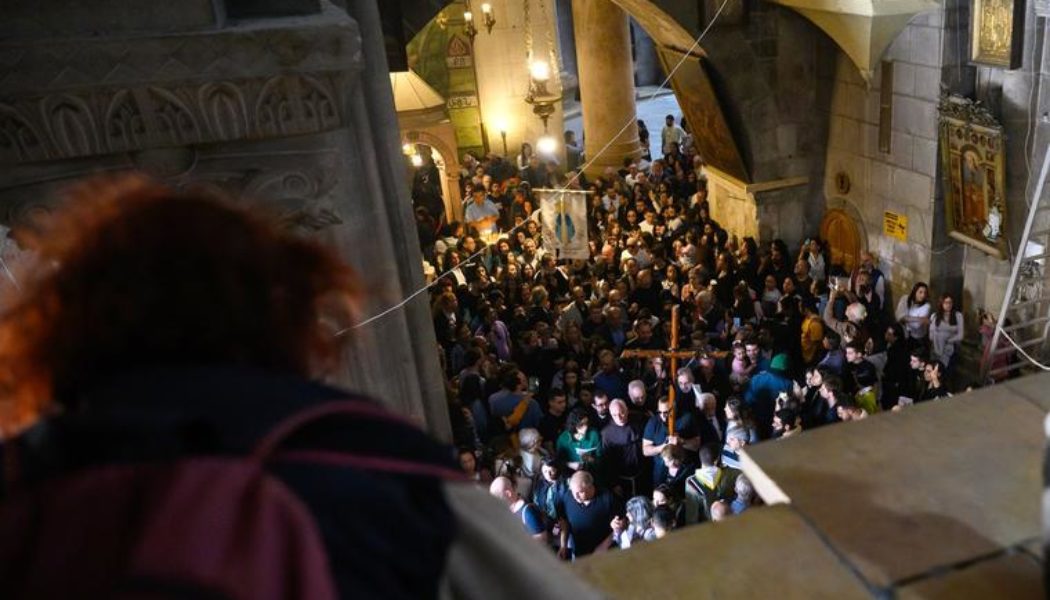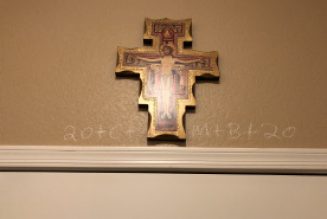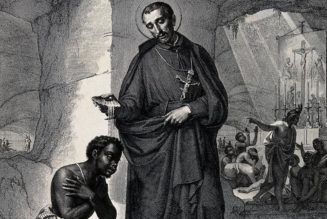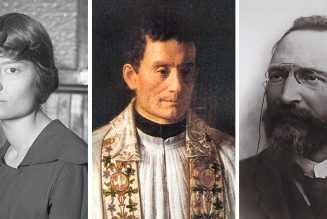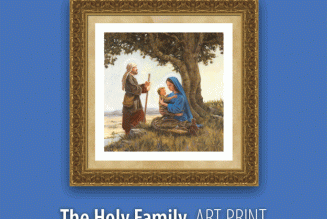
Friedrich von Hügel’s friend was dying, and he told his friend about his young daughter in her last illness. She had been “wonderfully plucky and courageous, ‘grinning and bearing,’ a dear stoic. But then gradually she became, in this too, more and more sensitively Christian. The Cross became, not simply a fact, to bear somehow as patiently as we can, but a source and channel of help, of purification, and of humble power — of a permanent deepening, widening, sweetening of the soul.”
That’s a good Good Friday thought, and expresses an insight into the kind of day Good Friday is. Good Friday is a day in which Easter is active, not just anticipated.
Hügel was one of the major theologians of his time (he died in 1925 at the age of 72). He’s not remembered much now, which is sad, because he was wise man. He kept all the truths in balance, not letting one dominate the others, in a world that tends to split them apart and value one above the others. (I wrote about Hügel’s dialectical understanding of living in the world here.) He’s mainly known for his wonderful book Letters to a Niece, a book of spiritual and intellectual direction, and a massive scholarly work, The Mystical Element of Religion as Studied in St. Catherine of Genoa and Her Friends.
To many of you the intimate connection of the two holy days will be obvious, but it was a truth I knew but didn’t see clearly. Like Hügel’s daughter, I had the Christianized stoic attitude down. Judging from conversations, others have the same challenge, some for the same reason.
Hügel helped me overcome an idea I’d absorbed from much of the teaching and preaching I’d heard, heard through my own stoic inclination. The idea too starkly separated Good Friday and Easter, turning the first into simply a necessary step to the second, something you had to push through, and once you got through it you could forget about it. One day of 100%, full flat-out grief and penitence, then another of 100%, full flat-out rejoicing. Easter is like a carrot on a stick getting the donkey to keep moving forward. Seeing Easter in Good Friday more clearly — more Christianly, less stoically — helped me look at my own crosses more clearly. That a Christian must take up his cross and follow Jesus, and that Jesus carries it with him, that I understood. But imaginatively, in the way I pictured it, I thought of it as a long, hard journey home, and did not clearly see that in some way I had already arrived at home even as I was carrying my cross there.
Always Suffering and Always Joy
Hügel didn’t write much about Good Friday, but he did write a lot about the Cross and the Cross’ place in our lives. He made clear to me that though the first led to the second and was the condition for the second, the second interpenetrated the first. That when I was carrying my own cross I was already experiencing the resurrection. The two days offer us a single experience, because Good Friday is itself a kind of Easter, because the experience of the Cross transforms us, as it transformed his dying daughter.
Here are a few quotes from his writings, mainly from Letters to a Niece, in which Hügel offers his insights in different ways.
“If we are Christians there are always two notes, suffering and joy,” he told his niece, and I think Good Friday illustrates precisely because it’s such a horrible day. Always these two notes, he said — so (as I understand this) when we suffer we have joy even if we don’t feel it and when we feel joy we also suffer even if we don’t notice it. “Gethsemane is awful, but it does not end with Gethsemane; there is the Resurrection. We want the whole of religion; renunciation and joy, the Cross and the Crown.”
He told her in another letter, “Our Lord saw that suffering was knit into human nature, but he … sees it is not the end. He sees the coming of joy, the suffering ending in the crown the coming of joy through and because of this suffering.” We see this in Jesus’ life, with “the great rejoicing in the spirit during the Galilean ministry” and also “the cry upon the Cross,” essential parts of the same life, the same life-saving life.
He explained in an essay called “Christianity and the Supernatural” that “the specifically Christian conception of Jesus Christ absolutely requires, not only the sufferings of the Passion, but also the Beatitude of the Risen Life; neither alone, but only the two, the bittersweet together form here the adequate object of our Christian faith.”
We have two great examples of this among the saints, he continued. One was “Catherine Fiesca Adorna, that unhappily married, immensely sensitive, naturally melancholy and self-absorbed woman, who ended, as the Saint of Genoa, on the note of joy and of overwhelming joy.”
The other was St. Francis of Assisi, who “next to Our Lord Himself, appears, amidst all the Saints we know of, to have most completely brought out the marvelous paradox of Christianity — utter self-donation with entire spontaneity, a heroism quite unrigorist, a devotedness of supreme expansiveness and joy.”
In another of his books, he quotes St. John Vianney: “You say it is hard to suffer? No, it is easy; it is happiness. Only we must love while we suffer, and suffer whilst we love. On the way of the cross, you see, my children, only the first step is painful. Our greatest cross is the fear of crosses.”
The One True Christian Reality
He hadn’t written her till after Easter, Hügel told his niece one year, because he wanted to write after they’d experienced through Good Friday and Easter, “the entire prism of many-colored fact and emotion — which only thus together give us the true Christian reality and life.” The true Christian reality came through only in the single experience of the two days together.
“The great fact, and even the commemoration of, Good Friday, would, alone, be too austere, too heartbreaking,” he wrote. “The great fact, and even just the feast of Easter, if alone” would not be enough without Good Friday, because without it Jesus “would not have drained the Cup — the bitter Cup — of the possibilities of earthly human life and earthly human interconnection to the dregs.”
We must have both, he saw, both in Jesus’ life as one of us and in our own. “Good Friday and Easter Sunday, the two together, each requiring the other, and we all requiring both — only this twin fact gives us Christianity, where suffering holds a necessary place, but never the place of the end, always only of the means.”
Hügel tells his niece of an insight from his friend Ernst Troeltsch, a great Protestant historian, and adds his hope for her, that she and he will be transformed through the Cross. Troeltsch “always marvels anew at that unique combination effected by Christianity — so earnest and so unrigoristic— so expansive and so full of suffering without morbidness, and of joy without sentimentality. We will all, please God, see this more and more every year, that these bitter-sweet, contraction-expansion, sacrifice serenity, great days come round.”
It’s the combination, the interpenetration, of Jesus’ two experiences that we observe — the first in sorrow, the second in joy — in the movement through Good Friday to Easter. One bitter day of contraction and sacrifice, one sweet day of expansion and serenity. And in the bitterness we feel sweetness, in the contraction we experience expansion, and in the sacrifice we find serenity.
